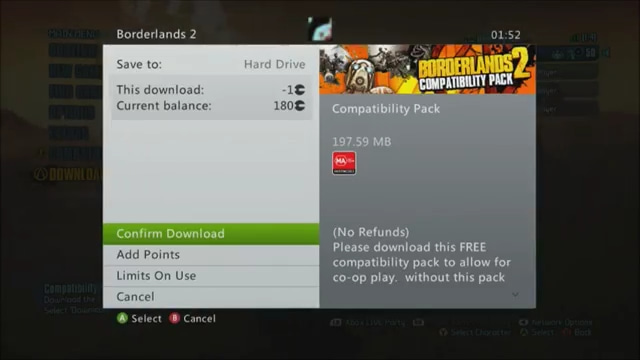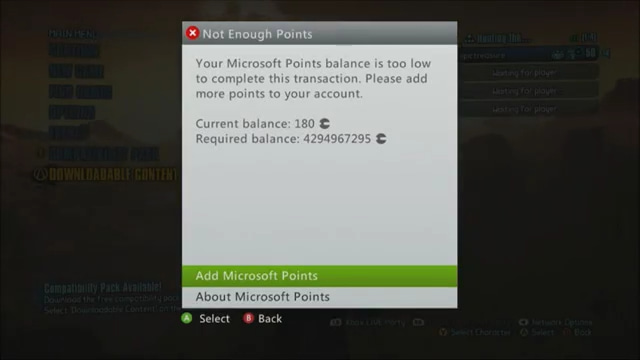Why did the Borderlands 2 compatibility pack cost -1 MSP, and then 4,294,967,295 MSP, simultaneously?
Well, somebody derped. Whether it was Gearbox or Microsoft, I’m not sure. Here are a few screencaps of the issue we’re talking about:


Here’s a short C code example of this problem.
#include <stdio.h>
int main()
{
int price = -1;
printf("Real price: %d\n", price);
printf("Derp price: %u\n", price);
return 0;
}
The output of this program is:
Real price: -1
Derp price: 4294967295
Wait, what? I didn’t type that crazy four billion number in my source code anywhere. So… what happened? Let’s dissect the code to figure it out.
int price = -1;
First, we declare a signed integer variable with the name price, and the value of -1. Because it is a signed 32-bit integer, this variable is capable of holding any number between −2,147,483,648 and 2,147,483,647. -1 will fit in there just fine. The declaration of this variable produces no output.
printf("Real price: %d\n", price);
We print out the price as a signed decimal integer, hoping all goes well. The %d part means “decimal integer”.
Real price: -1
Looking good so far.
printf("Derp price: %u\n", price);
Next, we tell the computer, “Hey! Go look at that price again but pretend like it’s an unsigned integer.” The %u part means “unsigned decimal integer”.
Derp price: 4294967295
Oh no. This does not look right.
A 32-bit unsigned integer can represent values between 0 and 4,294,967,295. -1 is not in that range. When we look at a signed negative integer as though it were an unsigned integer, it will show up as a really large positive number. Usually it will be some number above 2,147,483,647.
I don’t know what all that fancy code stuff means. Why did -1 turn into 4,294,967,295?
To store negative numbers in a computer, we use something called the Two’s Complement representation of a number. If we want to convert a number into its Two’s Complement representation, we follow these steps:
- Convert the number to binary as a positive number.
- Flip all the bits (1 becomes 0, 0 becomes 1).
- Add 1 to the number (in binary).
Let’s do this for -1.
Convert -1 to binary as a positive number.
110 = 000000012Flip all the bits.
111111102Add 1.
111111112
The computer would store -1 as 111111112 in a signed
representation, assuming our numbers are only 8 bits.
Unfortunately, our value 111111112 was forcibly
converted into an unsigned representation. Now it can now only be a positive
number.
111111112 = 25510
In Microsoft Points world, however, numbers are represented with 32 bits. We can apply the same series of steps to find that the 32-bit representation of -1 becomes a huge number.
111111111111111111111111111111112 = 4,294,967,29510
tl;dr:
I guess I'm not playing Borderlands 2 anytime tonight.